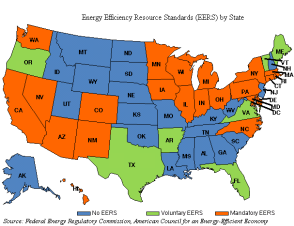States with EERS consume less electricity per capita than those without
Over the last decade, 29 states have created energy efficiency resource standards (EERS) or efficiency goals (see map below). These programs vary greatly from state to state; most of them are mandatory goals while some are voluntary, some have small savings goals while others are more ambitious, some have relatively near-term goals while others are more long-term, and each incentivizes or mandates savings in various ways.


Many of these programs have been in effect for several years now, and some states have emerged as more intensive users of electric energy than others, especially those without any EERS. One way to compare states' energy consumption at a glance is to look at the second map above (which is normally found in the End Use section), sshowing electricity retail sales per capita by state. All else being equal, a state with a high level of per capita retail sales (which we use in place of consumption) uses electricity less efficiently than a state with a low level of per capita sales. There are also other factors that will affect the level of retail sales per capita, including weather, regional fuel usage, industrial output, and population density.
This population-normalized comparison is useful in comparing the effectiveness of state energy efficiency policies. It should be noted that while residential sales will depend on population, electricity sales to commercial and industrial customers are less influenced by population. This would tend to raise per capita sales in states with large commercial and industrial activity relative to a state's population, as compared to other states. However, since efficiency programs apply across all customer segments, we use total sales. If one looks at residential sales alone, the results do not change much. Some of the less populous states like Wyoming drop down the list of sales per capita, while more populous ones like Georgia rise in the ranks. With either approach, states with EERS are more efficient in terms of sales per capita, particularly those with a more robust EERS, like New York.

For July, the population-weighted average per capita sales in the top 20 percent of per capita electricity sales (least efficient) were just above 1,800 kWh/capita, while those of the bottom 20 percent (most efficient) were about 680 kWh/capita. It is important to note that the 10 states in the top 20 percent are regionally diverse, which makes it less likely that regional factors are influencing the numbers significantly. Of the 9 states and the District of Columbia that make up the top 20 percent, only one of them, Arkansas, has a voluntary EERS. Conversely, of the 20 states in the bottom 40 percent, 16 have EERS, 12 of which are mandatory.
There are a few exceptions to the trend, notably Arkansas, Indiana, and Iowa, which have EERS but their sales per capita are high. These State's EERS have relatively low efficiency goals. These programs are also relatively new, all having been adopted in 2009 or later.
On the other side of the spectrum there are some states with no EERS that have low per capita sales like Alaska, which has a very low annual electric demand relative to other states. Another notable exception is New Jersey, which has the second highest installed capacity of solar power on a MW basis behind California due to the State's robust renewable energy goals and incentives to consumers for installing solar panels on their homes and businesses. It may be that not only are the many consumers of distributed solar power in New Jersey buying less power from their utilities, they also may be more aware of their energy usage and have adopted energy efficient practices as well.
We also looked at trends over time. Comparing 2002 and 2011 retail sales per capita data, states with no EERS programs had a per capita consumption increase of over 9 percent, while the states with mandatory EERS programs had an increase of just above 5 percent over the same period, a marked improvement. States with voluntary EERS had a per capita increase of almost 11 percent, slightly more even than the states with no EERS. This could be due to the fact that of the seven states with voluntary EERSs, only Vermont's and Texas's were instituted before 2010, so these states have only had a few years to begin saving energy.
Principal Contributor: Eric Schneiter (eric.schneiter@eia.gov)
http://www.eia.gov/electricity/monthly/update/index.cfm